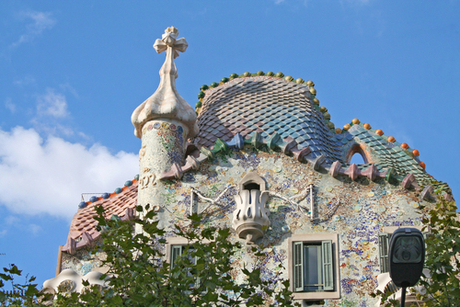Casa Batlló
Casa Batlló is a building restored by Antoni Gaudí and Josep Maria Jujol, built in the year 1877 and remodelled in the years 1904–1906; located at 43, Passeig de Gràcia (passeig is Catalan for promenade or avenue), part of the Illa de la Discòrdia (the "Block of Discord") in the Eixample district of Barcelona, Spain. Gaudí's assistants Domènec Sugrañes i Gras , Josep Canaleta y Joan Rubió also contributed to the renovation project.
Between 1898 and 1906 three adjacent houses in one block on the fashionable boulevard 'Passeig de Gracia' were built by some of the most important modernist architects: Casa Amatller (designed by Puig i Cadafalch), Casa Lléo Morera (designed by Domènech i Montaner) and Gaudí's Casa Batlló. All three houses were designed in a different interpretation of the modernist style in what seems like a competition between the architects. This lead to the local term 'Mançana de la Discordia', which means apple of discord, referring to Greek mythology where an apple, given by the goddess Eris 'to the fairest' lead to a dispute between three goddesses, eventually leading to the Trojan War. Conveniently the word mançana also means 'block', so the expression 'Mançana de la Discordia' can also be translated as 'Block of Discord'.
The local name for the building is Casa dels ossos (House of Bones), and indeed it does have a visceral, skeletal organic quality. It was originally designed for a middle-class family and situated in a prosperous district of Barcelona.
The building looks very remarkable — like everything Gaudí designed, only identifiable as Modernisme or Art Nouveau in the broadest sense. The ground floor, in particular, is rather astonishing with tracery, irregular oval windows and flowing sculpted stone work.
It seems that the goal of the designer was to avoid straight lines completely. Much of the façade is decorated with a mosaic made of broken ceramic tiles (trencadís) that starts in shades of golden orange moving into greenish blues. The roof is arched and was likened to the back of a dragon or dinosaur. A common theory about the building is that the rounded feature to the left of centre, terminating at the top in a turret and cross, represents the lance of Saint George (patron saint of Catalonia, Gaudi's home), which has been plunged into the back of the dragon.
Casa Batlló is one of the two great buildings designed by Antoni Gaudi on Passeig de Gracia, the other being La Pedrera
From the outside the façade of Casa Batlló looks like it has been made from skulls and bones. The "Skulls" are in fact balconies and the "bones" are supporting pillars. Gaudi used colours and shapes found in marine life as inspiration for his creativity in this building e.g. the colours chosen for the façade are those found in natural coral.
The building was designed by Gaudi for Josep Batlló, a wealthy aristocrat, as an upmarket home. Señor Batlló lived in the lower two floors with his family and the upper floors were rented out as apartments. This building is a stunning and original work and well worth the visit. If you decide to take a look around inside you will learn how much attention to detail Gaudi spent on his designs thinking about such things as varying window size depending on how high the window was from the top of the building. In this way he could ensure uniform lighting conditions in each room of the house. Audio guides are available from the front desk which will give you information on each of the rooms.
The house's interior is as fascinating as its exterior. Again, Gaudí avoids straight lines at all cost. Like in his next (and last) commissioned private building, the Casa Milá, he paid great attention to detail when designing the wooden doors, stained glass windows, colorful tiles and carved out fireplace. The house is accessible for tourists and is part of the "Gaudi works" tour. It is famous place of interest and lots of people place it in their plans for sightseeing when in the city. There are available tour guides, including the Casa Batlló, offered by any hotel in Barcelona.
Passeig de Gràcia is both one of the major avenues in Barcelona and also one of its most important shopping and business areas, containing several of the city's most celebrated pieces of architecture. It is a magnet to the tourists and attracts with luxurious hotels, designer’s shops and nice places to rest and have fun. You can get there via direct flight to Barcelona or to Girona, Reus or Lleida – Alguaire.




